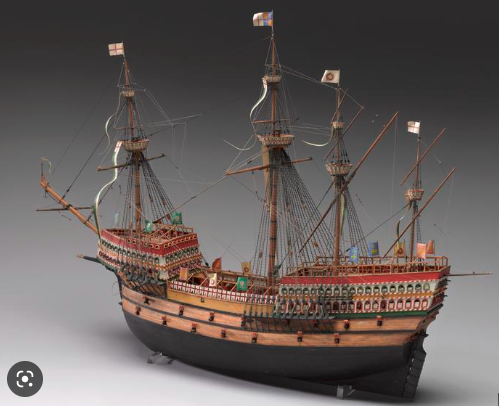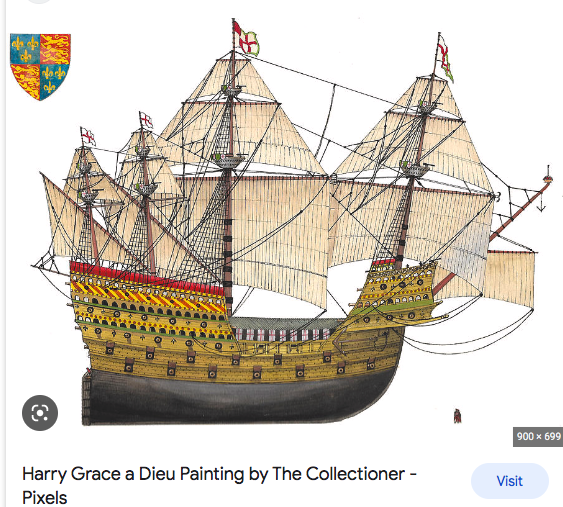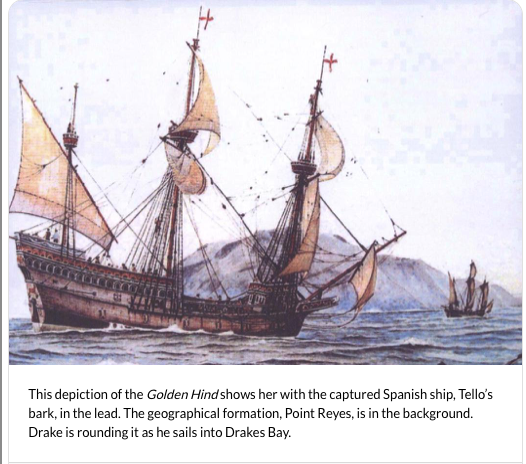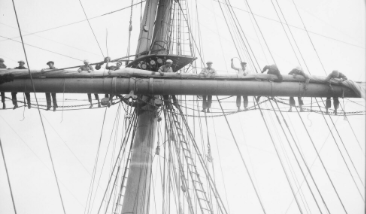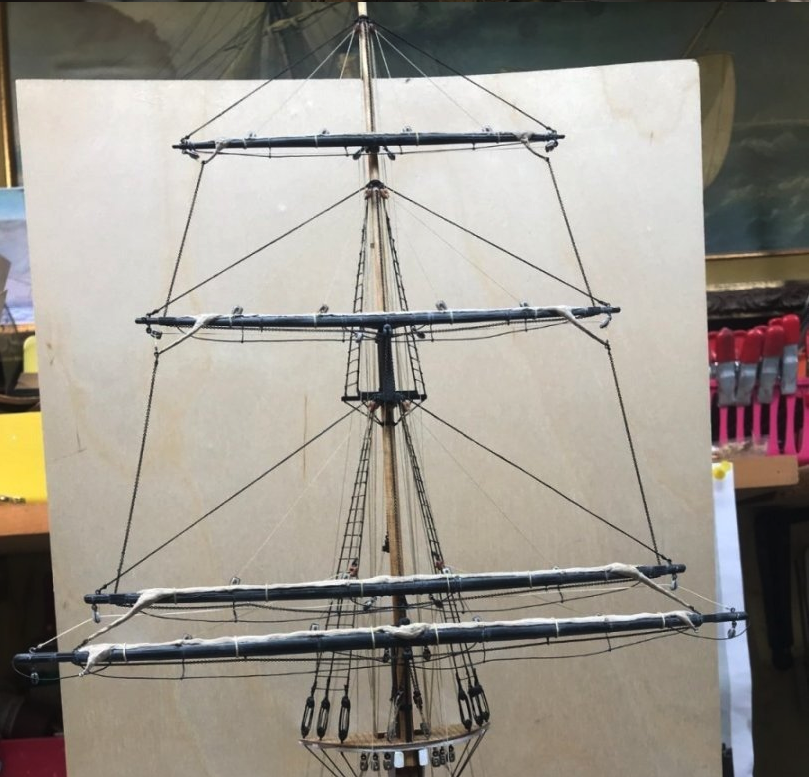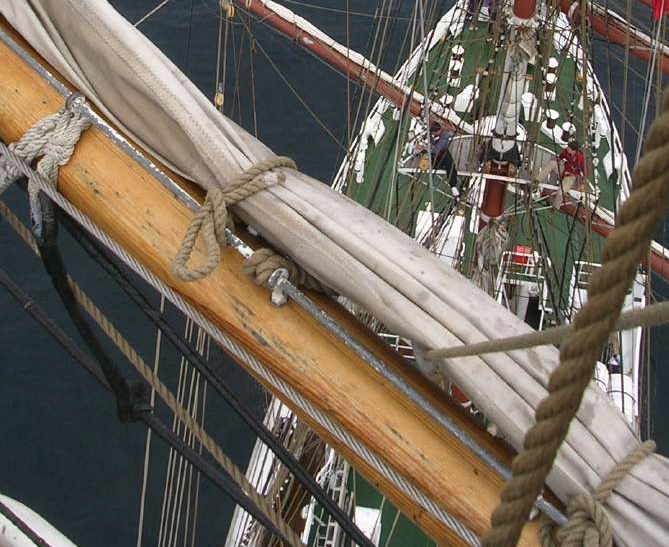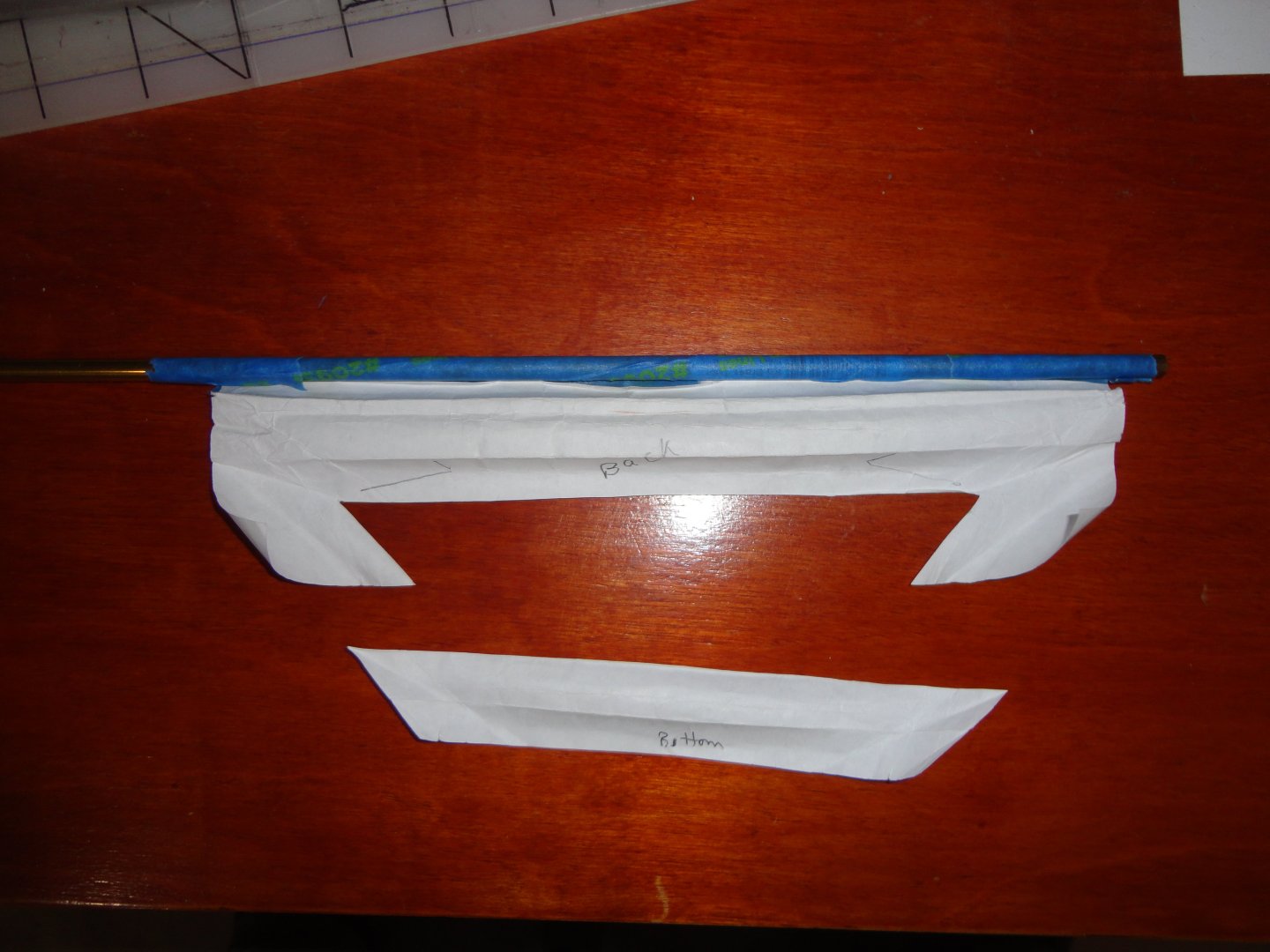-
Posts
1,439 -
Joined
-
Last visited
Content Type
Profiles
Forums
Gallery
Events
Everything posted by Snug Harbor Johnny
-
I've noticed that on the Anthony Roll, the first section of masting (as well as the bowsprit) seem 'impossibly' tall - topped by modest mast sections. This depiction is also seen in other contemporary art. Talk about instability in all but the lightest breezes. The old Sergal 1:65 Great Henry used proportions like that in the kit design, and examples of more recent art also take after 'Anthony Roll proportions'. Yet there are examples of what seem to be more likely (sea worthy) mast length proportions both in art and models as shown below:
-
G'day, mate! We're glad to welcome another member from 'down under'.
-
Bare wood model decks not in a case can get dirty over time, and fine dust can get in the grain of the wood. A thin coat of clear shellac or varnish can prevent this, and make future dusting/cleaning easier. Note that 'stain' has a tendency so soak into some of the grain more than other parts of exposed wood that can lead to uneven coloration. A way to limit this effect it to lightly apply a 'stain prep' or wood conditioner (Minwax makes a pre-stain conditioner) before applying colored stain. The prep soaks into the grain ahead of the stain - the exposed fiber end 'drinking' the prep like through a soda straw. With a few minutes rest, a light application of stain with a gathered lint-free cloth will lay some color over the prepared wood in a way that the color will be more even, with fewer, lighter dark areas.
-
Maybe an experienced European paper modeler can recommend the makers of the 'best' designed and assemble-able paper kits. This one (once a better Fokker kit is identified and obtained) can be the 'warm up' ... A crewman on a B-17 warned of a Fokker at 10 o-clock,, and a gunner replied, "You mean the Messerschmidt?" Said the crewman, "Yeah, THAT Fokker !"
-
If anything, when in doubt, start with a higher number (finer grit) paper first (like 320) and just see what it does. You can always go coarser if you need to, rather than start too coarse - that can put scratches in the wood that have to be further sanded down with finer grits to remove, and that can make the planking get too thin.
-
'Can't say enough good things about your whirlpool project, mate !
- 185 replies
-
- Flying Dutchman
- Black pearl
-
(and 2 more)
Tagged with:
-
Rob Riedderich used the 1:96 C.S. hull as a 'base' to make other clippers, with impressive results. Most know that Revell's 1:96 Thermopylae has the C.S. hull - and even though they nixed the second deck house, made a modified Thermie rear cabin and fudged the deadeye/shroud arrangement to be more like the Big T, that kit leaves a LOT to be desired. I've studied my stashed Thermie kit and pondered how to re-engineer the plastic Revell hull and deck to be 'closer' yet to the original, and the problems are manifold - too much to do to be practical. Often overlooked and yet essential, the subtle 'racing yacht' lines of the original T's hull are different than those of C.S. (the differences are thought to have given Thermopylae an advantage in light to moderate winds), and no wood kit ever got the T's lines right either. The correct lines are available on the internet, and can be scaled as desired. So I've studied and made drawings of those, with an eye to doing an 'old school' solid hull. We'll see if anythoing can come of that.
- 28 replies
-
- Cutty Sark
- Revell
-
(and 1 more)
Tagged with:
-
Greetings, Mate ! Check out builds over ships you're interested in ... lots of tips to find there. Snug
-

Holiday Fund Drive 2024
Snug Harbor Johnny replied to ferretmary1's topic in NAUTICAL RESEARCH GUILD - News & Information
Its neither 12th night or Orthodox Christmas yet, so please add my donation to the till. -

HMS Endurance 1/70 Scale by OCCRE
Snug Harbor Johnny replied to SaltyScot's topic in Wood ship model kits
Hornet's comments may apply to many of the moderately priced kits Occre sells, e.g: belaying pins that seem "fat" and out of scale (also too short for the scale they're in - presumably to avoid them breaking); 'average' rigging line supplied - which is par for the course in a majority of kits from many sources; not enough sizes of deadeyes (also they are white, so one must stain them dark) - also not uncommon in other kits; Hull lines vary in places from the known lines (not uncommon in many kits, but not hard to correct if desired); wrong size portholes for cabins (actually they are brass grommets - passible for the deck house, but the long stern cabin had no surface mounted portholes on the sides, just holes in the planking because the portholes were recessed) ... I could go on, but sacrifices were made to keep the price around $200 (varies depending on source). If the Endurance is is what someone WANTS to build out of interest in it, then the choice is between the only kit offered as a good base (as Grandpa Phil noted) to do with whatever level of accuracy desired (and some upgrade items will be purchased) ... OR they can do it from scratch for themself, with old kits (intact or partly built) as a source of some materials. If someone is looking for greater accuracy of some other ship all 'in the box' (regardless of which ship it happens to be, the object being to start a project without having to change much of anything), then a thorough researching of MSW kit reviews and builds is recommended before making any decision. But 'better' kits ... and a lot elsewhere has been asked and pondered elsewhere in our forum as to "what's the best kit"... will likely cost more to buy, and may still need a few 'upgrades' to get closer to 'authentic' - realizing that most ships went through configuration changes during their life. One should decide WHICH 'version' of a particular ship one is to build, based on what it was doing at a particular time (thus how it was configured THEN). E.g: There is the Polaris before it was converted and renamed Endurance, the Endurance as modified when it left England for South America (uncovered steering mechanism and no dog kennels yet), the Endurance when it left South America for Antartica, and the Endurance stuck on the ice where it was further modified for the Winter. The 'look' will be somewhat different for each version. -

HMS Endurance 1/70 Scale by OCCRE
Snug Harbor Johnny replied to SaltyScot's topic in Wood ship model kits
The first Endurance build log on MSW I followed was by Hake Zou, and he built it pretty much 'out of the box' and made a good looking model. Other builders have added their own logs with a few (or a lot) of modifications. You can have a look at them as well and pick and choose among any alterations that have been made ... or not. I did a kit review and found Occre's Endurance a good value. The builder doesn't have to deal with guns, gun ports, large numbers of yards, complex rigging or copper plating the underside. If you only substituted 'scale rope' (not costly) for the rigging, and perhaps looked at Hake's rigging suggestions, you'd likely appreciate the results. Fair Sailing ! Snug -
Eastern Europe has a long history of sophisticated paper modeling of all sorts of things. Of course paper is thin enough to be viewed as a two-dimensional material, and paper model design flows from how one can bend, twist, roll and otherwise join 2 dimensional components. I wonder if this background (school of thought or shared history?) is reflected in more recent kits coming from Eastern Europe. Model kits (non-ship) from U-Gears are laser cut on thicker wood stock, thus have a third dimension. But the U-Gears offerings are built like puzzles without having to bend pieces (for the most part). The Nitkin ship kits have a mixture of thick and thin wood parts, and the the planking does require bending. The pre-cut shapes of all the planks likely correspond to a certain "perfect" hull shape (determined in the design phase). The hull frames do have lines on each side to serve as a guide for how to fair them ... but get the builder only 'so close' to the theoretical ideal. Fairing is a tricky (artistic, actually) process where not trimming/sanding quite enough versus going too far can be measured in thousands of an inch (or hundredths of a millimeter). Perfectly 'faired' hulls (whether frames or bulkheads, with filler wood or not) won't have any 'kinks' or 'dips' in planking (or springy wire used to lay over a hull in progress to judge the fairing process) put over the exterior. A plank length designed to fit perfectly over an ideal faired distance will appear short or long in its place depending if the fairing along the hull covered by that plank is not exact. There's the rub! 2-D laser cutting cannot pre-fair ship frames, and frame assembly also produces slight positional variations in the framing that even 'assembly jigs' (on smaller models) can't completely prevent. With regular plank-on-bulkhead kits, one must cut, shape and fit one's own planks from long pieces of planking stock to conform to whatever fairing shape the modeler happens to have achieved on the hull. This may seem inconvenient to some, but the result will be appropriate for the hull being built. The concept of a 'fully engineered' kit where all the shapes have been pre-determined and will 'fit like a glove' is alluring indeed - but I fear that it will likely remain something of a "Holy Grail". We're forced to deal with at least a few assembly variables that still require a modeler to 'work around' a few surprises. But isn't that what model ship building is all about? So I wouldn't be too hard on Pavel because of the very high (and difficult) bar he's aiming for, and consider the 'partnership' of sorts that exist between kit designer and model builder. Consider the words of old Einar Billing, founder of Billing Boats: "The most important point is that this kit is intended to be built, and not merely assembled. In consequence, you must not expect the parts to fit together perfectly - it will be necessary to exercise skill and imagination in the building of this kit. I have tried to make the parts as accurate, and the instructions as precise as possible - but thought and care should be exercised during the construction. After all, any child can put a puzzle together. I wish you a lot of success in building your model."
- 58 replies
-
- Santa Maria
- Ships of Pavel Nikitin
-
(and 1 more)
Tagged with:
-
The amount of darkening varies from where in the tree a sample comes from - heartwood (older and deeper in the tree trunk) verses 'sapwood' (more recent wood laid down towards the outside of a log as the tree grows). There is likely a variation in chemistry. Also, different trees of the same species can vary in color, possibly due to genetic variation as well as differences in the soli components/nutrition on the spot where each tree stands. I've had mahogany darken long after being completely sealed in a a French Polished shellac, so I can't see how oxygen could get through the coating. (Oxidation does change unprotected wood more rapidly.) So perhaps the presence of light as well as a delayed chemical reaction may be the mechanism of action. Yet the change is on or near the surface, so re-cut or freshly sanded wood is light in color.
-

Hello from the Chesapeake Bay area
Snug Harbor Johnny replied to SaltyScot's topic in New member Introductions
Old timers from Maryland may remember National Beer ... From the land of Pleasant Living - Brewed on the shores of the Chesapeake Bay. -

Hello from the Chesapeake Bay area
Snug Harbor Johnny replied to SaltyScot's topic in New member Introductions
Ahoy, mate ! this early bird is glad to welcome you to MSW. I found that going through many builds of ships I found interesting provided a world of information - as well as tips and work-arounds to the occasional glitch that many model designs have. Of course, there are modelers in plastic, metal and paper here as well, but working in wood has many advantages - especially when it comes to redoing something. My #1 suggestion when building is to use 'scale rope' (bought or self-made) instead of the often 'fuzzy' thread one can find in a wood model ship kit. #2 might be to use better blocks/deadeyes. -
Don't forget the painting of Henry setting out for Calais - it shows shields all around the top decks - presumably supported by open railings - so archers could shoot through the gaps between shields and still have a lot of protection via the shields. Also, boarding netting would only be put up when the ship was readied for action with an enemy. Henry was on a diplomatic mission, so there are no nets in place.
-
Welcome aboard, mate ! You've come to the right place, I'll warrant.
-
Hmmmm, some 'older' kits (1970s?) have full size plans on multiple sheets (even if there are simplifications on rigging). But printing and including these is likely considered too expensive to include in contemporary kits. Yet the 'pot metal' cast fittings on these same kits often leave a lot to be desired, and often the blocks and deadeyes are metal. This was before laser cut technology, so many pieces are just printed on sheet stock for the modeler to cut out. Instructions are good on some and not so good on others (as they are today). There are often compromises made on detail and scale as well. Today, laser cut components make building easier ('though some components can be improved by the modeler) ... but gone are those large folded prints in many cases, and much of the instructions must be downloaded and printed on your own printer (unless you want to build on line) Fittings are often better, but not always to scale - or best proportion. So its a mixed bag. I was once active in astronomy, and was asked what was the 'best telescope' ... to which I said, "The one you use the most." There are many different types better suited to different observing goals. So also with ship kits - its a matter of taste. But the "best kit" is one that a builder actually finishes and has good recollections of the experience. The best remedy for sparse or unclear instructions is to research your subject first (and view completed builds of it on MSW) - taking screen shots for reference as needed.
-
This accomplishment will be hard to top !
- 185 replies
-
- Flying Dutchman
- Black pearl
-
(and 2 more)
Tagged with:
-
Another alternative for armament configuration is that shown in the depiction below (and a likely accurate one at that), with 6 guns on the lower deck (per side) and one on the deck above astern of the main shrouds - making for a broadside of 7. the higher gun would have extra range, and I've seen (but can't lay hold of right now) two French galleons having 5 guns on the gun deck (per side) and 2 on the deck above (a protected extension of the weather deck). So there are several plausible ways to go, at your discretion, any of which may be valid. An alternative to a pair of guns close to the bow (on the gun deck) would be two of lesser caliber (thus somewhat lighter) located on the forecastle deck (although the space is somewhat limited there), thus still 'at the bow' (bow chasers?). The lighter gun mounts could be angled at will to the side, at a more forward angle, or even ahead if the bowsprit sail was raised (or the yard for it positioned further down on the bowsprit. A lower position of that yard seems preferable anyway, so that the the helmsman manning the whip-staff in his shelter under the small poop deck would have a forward view that cleared the yard on the bowsprit. Once again, there are a number of permutations of options that can fit the period information know.
-

Furled , unfurled or no sails -Preference
Snug Harbor Johnny replied to Canada Steve's topic in Masting, rigging and sails
Just look look at 19th c. clipper photos showing furled sails, and its amazing how compact and 'un-bulky' they can be when sitting atop a yard - and there are a couple MSW builds that simulate this. Forget trying to take a cloth sail having the full area, then trying to bunch it. It will only take a narrow strip of thin cloth to look right. The top of the sail where it is bent to the yard or to jackstays is concealed by the folds of the sail plopped on top of the yard, secured by a few gammoning lines. Therefore there is no need to have jackstays at all, or to attach (bend) the bit of cloth to the yard ... no need to worry about reefing lines (and reef tackle can be omitted without much notice - even though it would still be there otherwise) ... and no need to fuss with cringles on a bolt rope or even to sew a bolt rope around the sail perimeter - only on the 'mouse ears' on the clews (bottom sail corners) sticking out, which will be the only sail edges that show. Gasket lines are fastened for quick release as shown below. Before jackstays, one end of the gasket could have an eye splice, and the quick release would be tied after first passing through the eye. No need to include a luff line, and one can have a couple bunt lines emerging from under the folded sail, thus no need for bunt blocks on the yards ... or the bunt lines can be omitted as well - another 'sleight of hand', as there will be plenty of rigging displayed on the model: Lifts for the yards, downhaul tackle where applicable, halyards, clew lines, sheets and braces. Of course, none of this affects the standing rigging done with darker rope. Before furling, the clews are hauled up by deck hands. Men on the yards lean forward and grab partway down the sail (an arms reach) and pull it up and over the top of the yard (leaning back a little as they do this in unison). Then by leaning forward again, that fold of sail is held by body pressure against the yard as another bit of sail is pulled up. Once gathered, the clews are pulled out a bit and allowed to hang. Canvas that is about .025" thick would only be .0005 at 1:48 scale - thinner than a sheet of paper ! So I did a little exercise to tape a strip of paper to a simulated yard, then fold the corners up and then folded the lot (origami style) on top of the "yard" ... and was able to tug out the clews to become 'mouse ears'. Below are a couple pictures of the concept to remove as much cloth as practical to portray a furled sail on a model. Instead of individual gasket lines, I just spiraled a line over the folded paper for convenience. On a model, there would be separate gammons spaced on the yard.
About us
Modelshipworld - Advancing Ship Modeling through Research
SSL Secured
Your security is important for us so this Website is SSL-Secured
NRG Mailing Address
Nautical Research Guild
237 South Lincoln Street
Westmont IL, 60559-1917
Model Ship World ® and the MSW logo are Registered Trademarks, and belong to the Nautical Research Guild (United States Patent and Trademark Office: No. 6,929,264 & No. 6,929,274, registered Dec. 20, 2022)
Helpful Links
About the NRG
If you enjoy building ship models that are historically accurate as well as beautiful, then The Nautical Research Guild (NRG) is just right for you.
The Guild is a non-profit educational organization whose mission is to “Advance Ship Modeling Through Research”. We provide support to our members in their efforts to raise the quality of their model ships.
The Nautical Research Guild has published our world-renowned quarterly magazine, The Nautical Research Journal, since 1955. The pages of the Journal are full of articles by accomplished ship modelers who show you how they create those exquisite details on their models, and by maritime historians who show you the correct details to build. The Journal is available in both print and digital editions. Go to the NRG web site (www.thenrg.org) to download a complimentary digital copy of the Journal. The NRG also publishes plan sets, books and compilations of back issues of the Journal and the former Ships in Scale and Model Ship Builder magazines.


